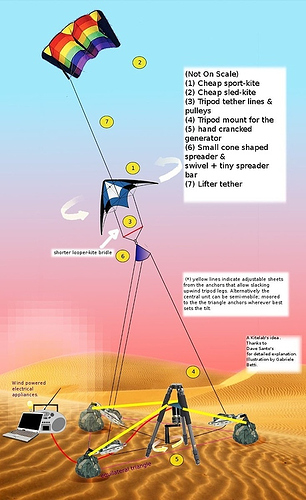I will qualify my last remarks. The favorable development of the Figure 5 does not seem obvious to me. However the tri-tether configuration as conceived by Dave deserves to be investigated. There is a picture below and some links about a tri-tether rig:
https://iopscience.iop.org/article/10.1088/1742-6596/1037/4/042023/pdf, the same on
https://www.researchgate.net/publication/325833533_Assessment_of_an_Alternative_Concept_for_a_High-Altitude_Wind-Power_Generator.
The figure 9 represents the curve of power for a 20 m², 5 kg paraglider at different wind speeds. The value of 6000 W at 9 m/s wind speed is about from 60 % to 75 % the expected average value for the same kite in pumping mode. The continuous power can compensate the lower value. Other advantages can be expected such like a better safety thanks to the three tethers.
